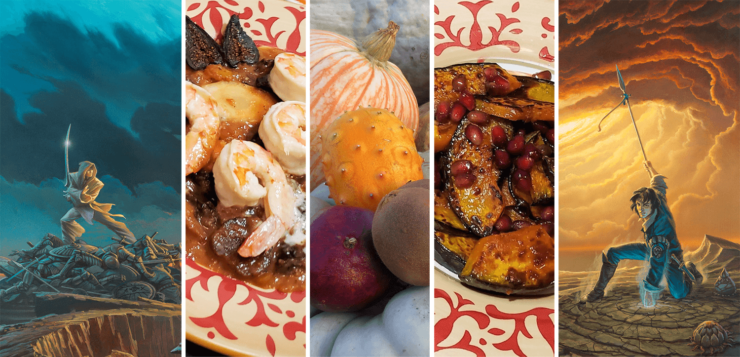Welcome as the Cosmere Cuisine tour arrives on Roshar, land of Brandon Sanderson’s ambitious epic, The Stormlight Archive. Roshar is a land of highstorms, glowing stormlight, shattered plains, and trees called “drop-deads.”
Throughout the series, readers are rewarded with a plethora of details and descriptions about the land, the various cultures, and—most importantly to me—the foods. The cuisine in Alethkar is not the same as in Azir or Emul; this article will focus on food in the Vorin Kingdoms, specifically Alethkar and Jah Keved. Part 2 will explore other lands on Roshar.
The plants and animals from Shinovar are those of Earth. The twist in designing Rosharan menus is that the plants from the rest of the planet do not act or grow like Earth flora. Many elements are going to be different. For some flavors, we have to accept “X is equal to Y” on Roshar, until we learn otherwise.
Warning: In discussing the Roshar foods, there are small spoilers from all the published Stormlight Archive books. Skip directly to the recipes, if you have not read Oathbringer.
Rosharan Foodstuffs
First, let us explore the available ingredients that make the food analogies possible. Remember, on Roshar they are using borrowed words for many items. This becomes extra clear when talking about food- and animal-related words. The old joke “everything tastes like chicken” applies very widely on Roshar.
The eastern lands on Roshar are the hardest hit by the highstorms. Their ecology is the most difficult with which to draw comparisons to Earth’s. The foods of Alethkar and Jah Keved are going to be different than Azir or even Thaylenah, which are both less affected by the highstorms. Culture plays a role in food. Even more important is the availability of local ingredients used to create meals.
The Plants
The plants of Roshar have adapted to deal with the equivalent of a Category 5 (and stronger) hurricane sweeping over the land on a regular basis. This means that much of the land is rocky, rather than covered in soil. Indeed, the concept for much of the plant life on Roshar is based on the kind of organisms found on a large coral reef.

Many plants grow in vine forms that can pull back into a better protected structure (like sea anemones). They also like to be in protected trenches. The crops that produce much of the food sources grow like gourds, pomegranates, or mangosteens. Rockbuds grow hard, waterproof outer shells that enable various edible substances to grow inside the protective barrier. Delicately skinned foods like strawberries, raspberries, and tomatoes are not going to grow outside of Shinovar. Foods that look more like cantaloupes, jackfruits, and coconuts are more likely to be native to Roshar. If grown on trees, they will not be as tall as our Earth version. For example, scalespray, shown in Shallan’s sketchbook, looks and tastes like kiwi fruit, according to Ben McSweeney, the artist, yet the plant only grows as tall as a human (whereas in our world, kiwi vines can grow to a length of around 40 feet, if left unpruned).
We know the names for five Rosharan grains: lavis, tallew, clema, treb, and Shin wheat. There are many different types of grains available, and just as “chicken” means “bird” on Roshar, each of these names must act as kind of a catch-all phrase for describing different kinds of edible grain crops.
Based on book clues, the lands outside of Shinovar and Thaylenah have non-glutinous grains. Breads in the eastern lands are not “fluffy,” but rather there are a variety of flat breads. Lavis is a major grain on Roshar, and is the equivalent of corn according to Dragonsteel. The lavis “polyps” are like corn kernels. Thus, a host of corn-based recipes are open to us Earth-bound cooks: corn tortillas, corn succotash, popcorn, even corn cob jelly. In Oathbringer, Shallan enjoys some “sweet and crumbly” lavis bread, which sounds like the perfect description for cornbread.
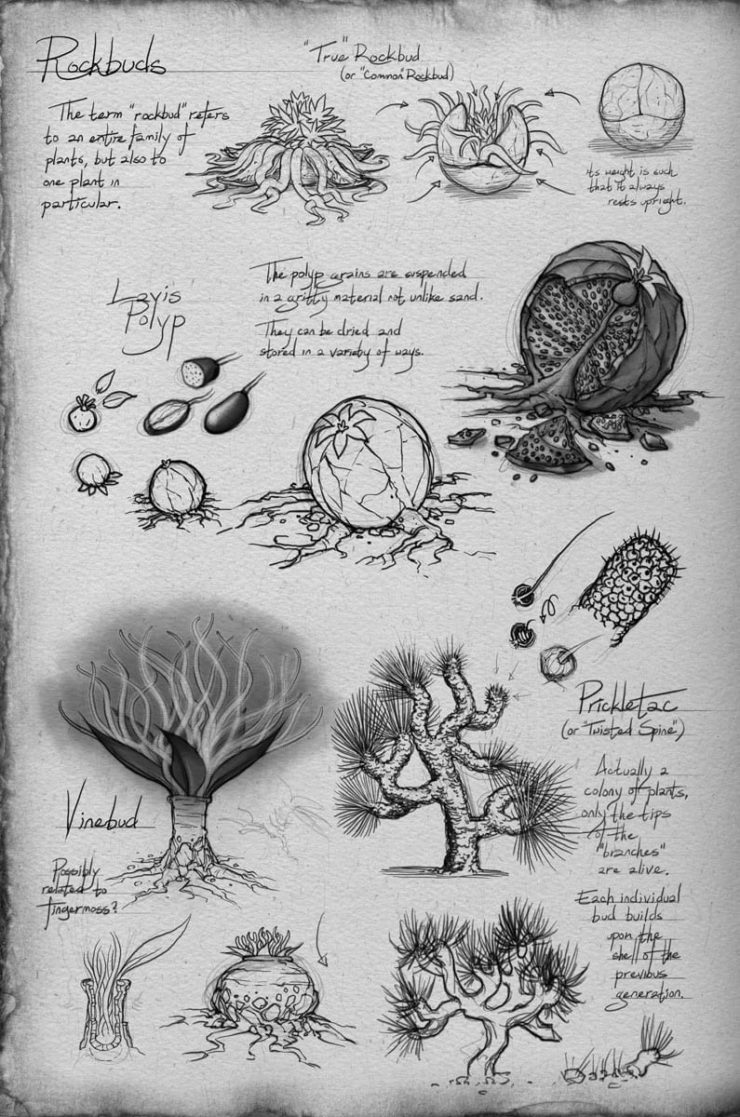
The other grains have not been given official Earth equivalents, but I like to think they are rice (tallew) and buckwheat (clema). These grains are gluten free, tolerant of poor soil conditions, and have shorter growing seasons compared to many other grain plants. A short ripening cycle would be important on Roshar due to the lack of traditional seasons. Rosharan plants probably flower and ripen multiple times a year, between the weather cycles and the 500-day length of their year. All these grains also have a large number of uses in the production of food and drinks for both animal and human consumption.
The fruits and vegetables on Roshar are like the grains, grown in various ways, but with protective outer coverings that are not edible. Roshar has a wide range of melons and berries that can be made into jam. Palafruits are noted to have seed pits, like peaches, lychee, plums, or avocados. Foods that grow like lentils, beans, peas, and chickpeas are perfect candidates for Rosharan ecology—in fact, I believe hummus is very much like the “bean pastes” Kaladin eats while in prison.
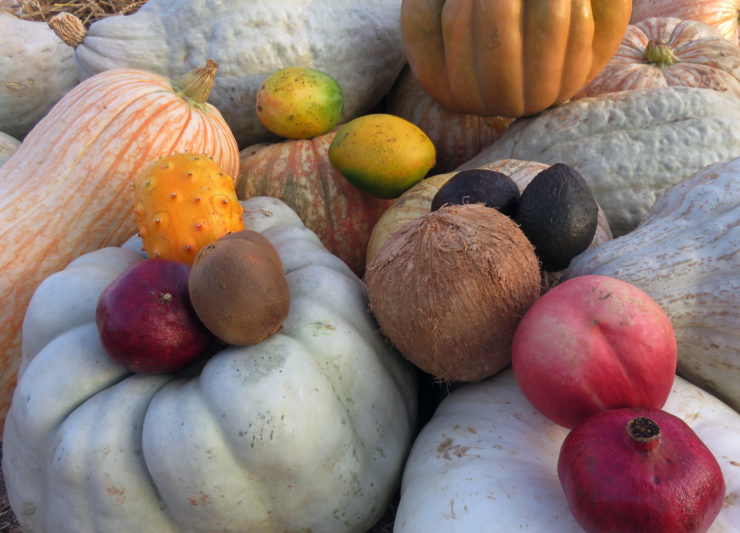
Sanderson has said that sweet potatoes are among the most common and popular vegetables on Roshar. Therefore, root vegetables are viable options. One is called stagm, described as a brownish tuber that grows in deep puddles. This description could apply to potatoes, yams, cassava, taro, or many other foods. So I’ve reserved the designation of treb for cassava root, which can be cooked by itself, or turned into a flour useful for many applications. Cassava flour is one of best gluten-free flours to use as a substitution for wheat flour, as well.
Cooks on Roshar will have multiple options when it comes to making foods sweet, as well: Honey from honey bees is unlikely on Roshar—not even in Shinovar—but other animals could produce a honey-like product. There are also plant-based sugars like beets, agave, fruit concentrates, tree syrups, and a form of cane sugar.
The vast number of spicy foods presented in the books leads me to believe that almost any type of spice you can imagine can be found on Roshar. It might look different there, but if you like cooking with a spice—add it to Rosharan meals! Be the spice from a seed, a fruit, or a tree bark…the one exception would be grape seeds. According to Sanderson, there are no grapes on Roshar.
Meat and Dairy
When considering the animals that people might eat on Roshar, the first one many fans will think about is chicken. Again, because “chicken” is the general term for “bird,” and we all love to make jokes about it… So when characters in the books eat chicken, it could be a duck, pheasant, turkey, or what Earthlings would actually call a chicken. There are no native Rosharan birds, so the ones we see were brought with the humans. (Shallan was too startled by her encounter with a brightly colored green “chicken” for parrots to be common in Vorin lands, and I’m guessing they are not a bird people eat there.)
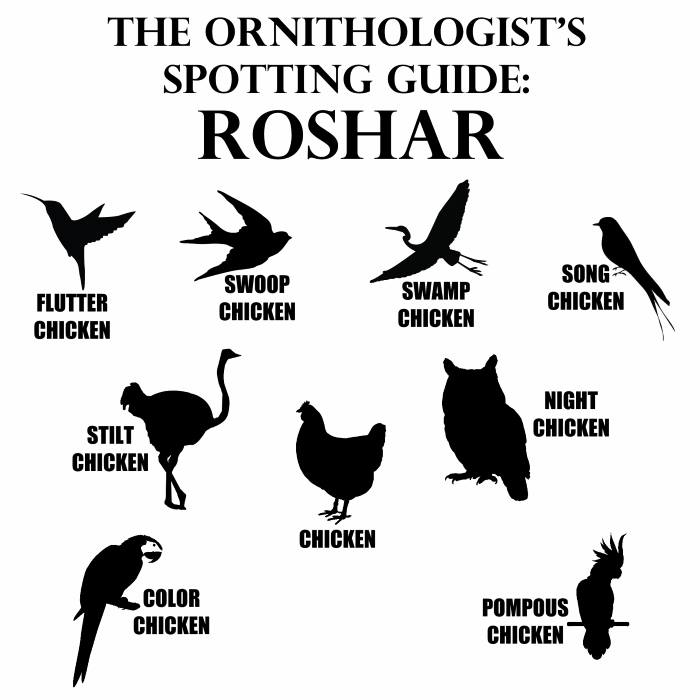
There are a number of pigs, goats, ferrets, fish, and the various types of shelled creatures that inhabit the planet. “Cremlings” is another general term on Roshar—any type of shellfish from Earth can be called a cremling, from king crabs and crawdads to clams and scallops. Since they are so common, they will be considerably cheaper there than on Earth (unless you happen to live near lobster-rich seas and get to regularly enjoy cheap seafood).
When I read the description of a chasmfiend, I envisioned a large lobster. Then I immediately wanted a huge vat of clarified butter to enjoy with a boiled beast claw. This led me to the discovery that on Roshar butter comes from pig milk. Dairy and beef cows might exist in Shinovar, but we don’t know for sure.
The pigs of Roshar have been bred to produce more milk than their young need, much like milk cows were bred on Earth to over-produce milk. We see references to cheese regularly in the books. Pig cheese on Earth exists, but it is not economically feasible to produce. Based on the books’ description of it as salty and crumbly, I think feta cheese is a good comparison. When cooking, using goat or sheep milk products would be an appropriate substitution for their Rosharan pig milk equivalents. Sanderson has not described the pigs on Roshar, but did give me permission to say they are based upon the Mangalica pigs. This pig breed has a woolly coat, almost like a sheep, and a very flavorful meat. I enjoy the contrast of all the shelled creatures compared to this particular breed, which does well in harsher environments.
Besides pig milk, goat and sheep milk would be available, along with their by-products. Not using them as the default is an example of Sanderson using the “Rule of Cool” in his worldbuilding. Rosharan meals use plant milks as well. Besides knobweed sap, for healing, we have not visited them in-world, so can only speculate at the types used. Coconut, almond, and rice milk would all be obvious choices for cooks looking to approximate Rosharan meals and flavors.
Vorin Cuisine
In The Stormlight Archive, Sanderson has set up a very unique complication by making meals a gendered issue in the Vorin faith, dividing types of food into feminine and masculine categories (unless one is an ardent and allowed to ignore the gender rules). According to these rules, in the Vorin kingdoms, adult men eat spicy dishes; adult women eat sweet dishes. Children are supposed to eat another, different type of dish. Practically speaking, women like Hesina do not have the time or the ingredients to cook three different dishes every dinner, and the rules aren’t always strictly observed. Divisions of this nature would be possible in a large, rich household, but not in the more modest homes.
There is also the inevitable division of foods based on social ranking—the rich eat better than the poor, simply because they can afford greater variety and more food, in general. The Vorin cultures have codified these social classes into ten levels of Dahn (lighteyes), and ten of Nahn (darkeyes). Nothing says upper Nahn families can’t be rich, and eat like wealthy Dahn. In poor families, it would be particularly hard to follow the sweet/spicy food division rules, partly because both sweet ingredients and spices typically cost more spheres. However, all cooks know there are ways to take basic ingredients and then push them in any flavor direction.
The primary inspiration for many of the Vorin recipes came from the Indian subcontinent, due to Sanderson calling many dishes “curries.” Another beta reader, Kalyani Poluri, an expert cook in Indian cuisine, consulted with me on these dishes, helping me to develop multiple recipes. I also looked towards Korean dishes due to Sanderson’s time living in South Korea and the ways in which those flavors seem to be reflected in the food of Roshar.
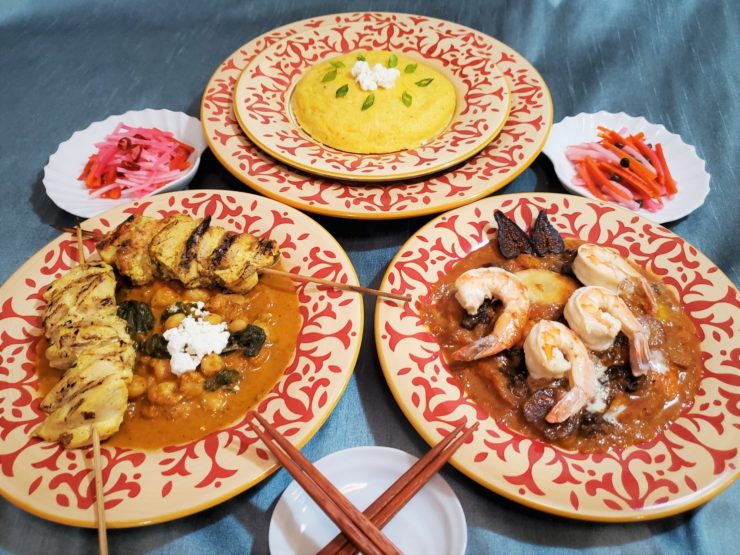
Goat Cheese Polenta
All meals need a platform. With lavis being corn-like, I thought a flavorful polenta would be a good starting base to serve with a saucy curry. For those wondering, yes, shrimp and grits could be a Rosharan meal, from what we know so far about the available ingredients! I suggest serving the shrimp blackened for the men and with coconut shrimp for the women, if you want to adhere to Vorin customs.
Ingredients
- 1 cup yellow cornmeal (I used coarse grind)
- 2 cups whole milk (I used goat milk)
- 1 cup water
- 1 cup soup stock (I used chicken stock)
- 1 teaspoon kosher salt
- 2 tablespoons unsalted butter
- 2-4 ounces crumbled feta (to taste)
- 1/4 teaspoon black pepper (to taste)
- Garnish with goat cheese and green onions
Directions
- Combine milk, water, stock, and salt in a heavy two-quart saucepan over medium-high heat.
- Just as the mixture begins to simmer, whisk in cornmeal gradually. Lower the heat and whisk vigorously to avoid lumps. Then whisk frequently over the next several minutes so the polenta does not stick to the pan.
- Whisk occasionally over the next ten minutes, maintaining a gentle bubbling over low heat.
- At 11 minutes, add butter, whisking well until combined.
- At 15 minutes, add the desired amount of feta cheese. Smaller crumbles will melt in better, so you can save the larger chunks for a decorative topping.
- Cook for 5 more minutes, for a total of 20 minutes.
- Serve polenta warm with other foods.
- If planning to reheat later, spread leftovers into a baking dish. Store in an airtight container in the fridge. It will firm up, then can be cut into squares as needed. When reheating, heat these pieces up like you are frying small pancakes for best results.
* * *
Vorin Curries, Served Two Ways
The recipes are examples of how the same general ingredients can be pushed into being spicy (“masculine”) dishes or sweeter (“feminine”) dishes with a limited number of changes. The recipes call for tomatoes, so we just have to accept that on Roshar, something hopefully grows that tastes like a tomato and is widely available. Same with garlic—they have it, but it doesn’t grow like it does on Earth.
Basic Curry
This is the base for any curry you want to make. Start here, then add other ingredients to develop flavor combinations you enjoy. If you use a stick of cinnamon bark, rather than small pieces, be sure to remove it from the dish before you puree the sauce. I personally hate the texture of onions, so I cut them as finely as possible before cooking them. Since the curry is pureed, the onions disappear, which I prefer. If you like more texture to your sauces, do not purée the sauce base, but do cut your tomatoes finely to begin with.
Ingredients
- 5 large tomatoes, diced roughly
- 1/2 a medium red onion, diced
- 2 small pieces of cinnamon bark
- 4 cloves
- 1 bay leaf
- 1/2 teaspoon cumin seeds
- 5 cardamom seeds grounded into powder
- 2 tablespoons vegetable oil
- 1 tablespoon ginger-garlic paste
Directions
Make or buy your ginger-garlic paste.
- Sauté cumin seeds in the oil until they start to splutter.
- Add cinnamon, cloves, bay leaf and cardamom powder.
- Add diced onions and sauté them, until they are transparent.
- Add diced tomatoes and simmer them on medium heat for 15 minutes or until they are cooked.
- Remove the bay leaf and then purée the rest after it has cooled at least 5 minutes. Leave with some texture to the tomatoes.
Recipe should make about 4 cups of curry base
* * *
Carrot, Fig, and Plum Sweet Curry
The “sweet” aspect of feminine dishes does not mean everything is like a sugary dessert. It just means that sweeter notes will dominate the dish; it can have spice, but the spice will not overwhelm the dish. Substitutions for other vegetables and fruits are something I encourage everyone to play with.
Ingredients
- 2 cups basic curry
- ½ cup milk (I used coconut)
- ½ pound of sliced carrots (I used heritage, so they are not all orange)
- ¼ cup dried plums, diced
- ¼ cup dried figs, sliced
- 1 tablespoon sugar
- ½ teaspoon kosher salt
- 1 teaspoon garam masala
- 1 teaspoon of vegetable oil
Directions
- Heat oil and add the basic curry to a large skillet.
- Add sugar, salt, and garam masala, mix well until the sugar is dissolved.
- Add milk to adjust the consistency. I used coconut milk to make it a bit sweeter. Will be a thick sauce.
- Add sliced carrots, diced plums, and figs. Let the curry simmer until they are tender. The carrots take more time to cook, so add them a few minutes before the fruits.
- Garnish the curry with a sliced fig and protein of choice.
* * *
Chickpea & Spinach Spicy Curry
The spice level to achieve “spicy” in a masculine dish is a sliding scale. What is spicy to one person could be mild to another. It doesn’t mean the Scoville scale must be cranked up to the highest level for every dish. Make it spicy to your taste, not to food-challenge levels. Apply some of the same caution for garam masala, especially when freshly made. It can be a very powerful spice blend, so use it to your taste level. In developing your own masculine dishes, feel free to add a wider range of peppers and heat elements to the spicy dishes. As a reminder, dairy can help pull back heat levels—I find feta garnishes handy when serving spicy dishes.
Ingredients
- 2 cups basic curry
- ½ cup milk (I used goat)
- 2 teaspoons of garam masala (to taste)
- 1 teaspoon of chilli powder (to taste)
- 1 teaspoon turmeric
- 1 teaspoon+ of kosher salt (to taste)
- 15 oz can of chickpeas: pre-cooked, drained, and rinsed
- 4 oz of spinach
- 1 teaspoon of cooking oil
Directions
- Heat oil and add the basic curry to a large skillet.
- Add 1 teaspoon of garam masala and salt to taste. Mix in well. Add in more of both to your liking.
- Add milk to adjust the consistency. Will be a thick sauce.
- Let the curry simmer on medium heat for 2 minutes.
- Add the chickpeas and the spinach. Mix in well.
- Let curry simmer for another 8 minutes.
- Garnish the curry with a bit of feta cheese and protein of choice.
Vorin Proteins
While the curries can be eaten on their own, I’ve chosen to present them paired with the recipes below. You could enjoy the meats on their own or pair with curries of your own development. The mix-and-match approach would be common based on the meals shown in the books. Or, you could serve only one type of protein with two different curries, as the innkeeper does for Shallan and Wit in Oathbringer. Create a meatless “protein” by serving vegetarian koftas (balls) often made of potatoes, paneer, or other vegetables. While none of the recipes below use pork, I believe it would be a very common and cheap protein on Roshar, given the abundance of pigs mentioned.
Coconut & Garlic Shrimp
Ingredients
- 1 pound jumbo shrimp, cleaned and deveined
- 1 cup water
- 6 cloves of garlic OR 2 tablespoon of ginger-garlic paste
- ½ teaspoon kosher salt
- ¼ cup lime juice
- 1 tablespoon oil
- ¼ teaspoon pepper
- 1 cup of coconut milk
- 2 tablespoons of stock (I used chicken)
- ¼ cup of toasted coconut
Directions
- Make shrimp marinade by first finely chopping the garlic.
- Add 5 garlic cloves (or 1 ½ tablespoons of ginger-garlic paste), water, lime juice, and salt to a bag. Close and shake well.
- Add shrimp to the bag. Seal and close. Marinate for at least 10 minutes.
- Heat oil on medium-high heat in a saute pan. Add remaining garlic (or paste) and pepper to the pan.
- Add coconut milk and stock to the pan. Mix well, let simmer a few minutes to allow flavors to blend.
- Add shrimp, cook on one side for 1 minute. Flip shrimp, cook for 30 more seconds.
- Serve warm. Garnish with toasted coconut
* * *
Grilled Rosharan Chicken Skewers
Ingredients
- 2 pounds of chicken cut into 2-inch pieces
- 1 cup sour cream (If you can find it made from goat milk—great!)
- ¼ cup milk (I used goat)
- ½ cup red onion, diced
- 1 tablespoon lemon juice
- 2 teaspoons ginger-garlic paste
- 2 teaspoons garam masala
- 2 teaspoons chopped cilantro
- 1 teaspoon kosher salt
- ½ teaspoon turmeric
- ½ teaspoon paprika
- ½ teaspoon cumin
- ½ teaspoon cayenne
- Cooking oil for grill
Directions
- Make the marinade by combining sour cream, milk, onion, ginger-garlic paste, lemon juice, cilantro, salt, and all the spices in a bowl.
- Add the chicken pieces to the bowl. Mix to coat pieces well. Cover and refrigerate for 4-6 hours.
- Remove from the refrigerator 30 minutes before needed. At the same time, start soaking wooden skewers in water.
- After the 30 minutes, thread the chicken pieces on the skewers.
- Preheat a grill to medium high heat. Coat the grill grates with oil.
- Grill the skewers, rotating as needed. Chicken should be done in 10-20 minutes.
Side Dishes
At the Highprinces’ feasts, they serve a number of dishes, so people can choose to have small portions of many different items. The recipes below focus on taking the basic ingredients served two different ways. This reflects Vorin ideals about food, while being more practical for an average family to create.
Carrot & Radish Pickled Salad, Served Two Ways
This dish can be served as part of the meal or as a palate cleanser at the end.
Ingredients
- 10 ounces daikon radish, julienned
- 10 ounces Carrots, julienned (I used heritage, so they are not all orange.)
- 1 cup water
- 1 cup white sugar
- ½ cup white vinegar
- ½ cup rice vinegar
- ¼ teaspoon kosher salt
- 5 dried peppers, diced and de-seeded
- ¼ teaspoon crushed red pepper
- Capers or more peppers for garnish
Directions
- Julienne the radishes and carrots (if you use a mandoline, be careful not to cut yourself).
- Put equal portions of carrots and radishes in two different clean, airtight containers.
- Make brine by adding water, sugar, salt, and vinegars into a pot, bring to a boil on a medium heat. Stir to dissolve the sugar. Let boil for 5 minutes.
- Remove from heat and let brine cool for 15-20 minutes.
- Add diced and crushed peppers to one of the containers.
- Pour equal amounts of the brine into the containers so that all the vegetables are covered.
- Close the containers, let them sit on the counter for 3-4 hours before moving into the refrigerator. Chill for at least 1 hour before serving.
- Can be kept in the refrigerator for 2 weeks—longer if you take the full steps to seal them in pickled jars. Rock would want you to eat them inside the first few days, while they are crunchier.
- Serve in small portions with the meal. These salads make a great pallet refresher. Garnish with peppers for the spicy, and capers or mint for the sweet.
* * *
Roasted Kabocha Squash, Served Two Ways
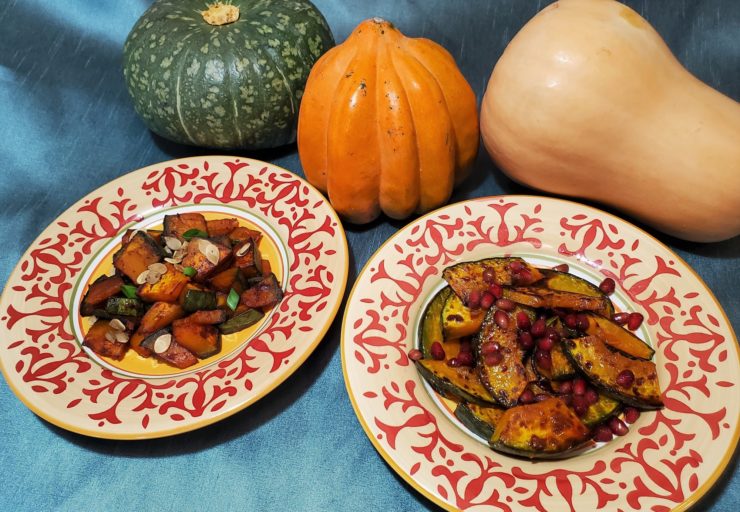
Kabocha squash, also known as Japanese pumpkin, is a sweet squash that is relatively easy to find in grocery stores. However, if you can’t find them, these recipes can be made with most other types of squash. Kabocha has a skin thin enough to eat it once cooked. Some people prefer this squash when the skin is removed. Adding roasted seeds gives a nice crunch to the dishes, which is Rock-approved but friendly to human teeth.
Roasted Squash with Pomegranate Glaze
Ingredients
- ½ a medium kabocha squash (about 7” across)
- 1 cup pomegranate juice
- ¼ cup sugar
- 2 teaspoon kosher salt
- 4 tablespoons butter
- 2 tablespoons pomegranate seeds
- Cooking oil
Directions
- Preheat the oven to 425 degrees.
- Cut the squash into even pieces. Remove the seeds. Toss pieces in oil and 1½ teaspoons of salt.
- Spread out on a cooking sheet in an even single layer.
- Roast the squash for 20 minutes, flip after 10 minutes. Should be fork tender; if not, cook longer in 5 minute intervals.
- Make the glaze. Add pomegranate juice, sugar, ½ teaspoon of salt, and 2 tablespoons of butter. Whisk occasionally, let it simmer and reduce on a medium low heat. Should thicken and be able to coat the back of a spoon.
- Once squash is roasted and glaze is reduced, finish it in a skillet: Melt 2 tablespoons of butter in a skillet, add squash, half the glaze, and pomegranate seeds.
- Serve warm, can cover with more glaze if desired.
* * *
Roasted Squash with Gochujang and Roasted Seeds
Ingredients
Squash:
- ½ a medium kabocha squash (about 7” across)
- 1 tablespoon gochujang
- 1 tablespoon vegetable oil
- 2 teaspoons soy sauce
- ½ teaspoons sesame oil
Seeds:
- All seeds from one squash, cleaned
- 1 tablespoon cooking oil
- ½ teaspoon kosher salt
- ½ teaspoon garlic powder
- ¼ teaspoon black pepper
Directions
Squash:
- Preheat the oven to 425 degrees.
- Cut the squash into even pieces. Remove the seeds, save in a bowl for later.
- Mix the gochujang, vegetable oil, soy sauce, and sesame oil in a bowl to make a glaze.
- Add squash to the gochujang mixture, toss well to coat.
- Spread out on a cooking sheet in an even single layer.
- Roast the squash for 20 minutes, flip after 10 minutes. Should be fork tender; if not, cook longer in 5 minute intervals.
- Serve warm, garnish with roasted squash or sesame seeds
Seeds:
- Preheat oven to 275 degrees.
- Clean the seeds by rinsing with water and removing the strings. Pat dry.
- Toss in oil with salt, garlic, and pepper.
- Spread out on a cooking sheet in an even single layer.
- Roast seeds for 15 minutes, turning them after 7 minutes.
* * *
With these last bites, our food journey in the Vorin Kingdoms comes to an end. And before anyone asks “What about Rock’s stew?”—Chouta and stew recipes are coming in the next Cosmere Cuisine article. Roshar is large, and Sanderson has given us enough clues to develop a set of recipes for lands not bound to Vorin food traditions… In the meantime, enjoy these flavors from the stormswept lands of Roshar!
Deana Whitney is a foodie, researcher, and a Sanderson beta reader. The Rosharan menus were the largest challenge of the Cosmere Cuisine series. They took much longer to develop than she intended. Reading Rhythm of War and everyone’s reactions to it, will be a highlight of 2020.










